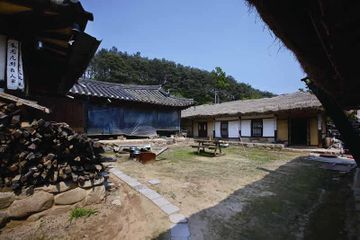"제천 박용원 고택"의 두 판 사이의 차이
(→영문) |
|||
| (사용자 2명의 중간 판 3개는 보이지 않습니다) | |||
| 1번째 줄: | 1번째 줄: | ||
| − | |||
{{문화유산정보 | {{문화유산정보 | ||
|사진=제천박용원고택.jpg | |사진=제천박용원고택.jpg | ||
| 37번째 줄: | 36번째 줄: | ||
'''Bak Yong-won’s House, Jecheon''' | '''Bak Yong-won’s House, Jecheon''' | ||
| − | This | + | This large farming house consists of a women’s quarters, a men’s quarters, an outer quarters, and a storehouse. The women‘s quarters was built in 1864, while the men’s quarters and outer quarters were built in the early 1900s. The buildings are arranged to form a square layout around a central courtyard. |
| − | The women’s quarters | + | The women’s quarters, which is shaped like an L and is located in the rear left of the property, consists from left to right of a kitchen, two underfloor-heated rooms, a wooden-floored hall, and two more underfloor-heated rooms. The wooden-floored hall features a designated area that serves as an ancestral shrine, as well as an elaborately designed ridge post, which sits atop the main crossbeam to support the ridge purlin. The ridge post‘s design, which consists of several smaller components rather than one single component, is rarely found in commoner’s houses. |
| − | |||
| − | |||
| − | |||
===영문 해설 내용=== | ===영문 해설 내용=== | ||
| − | 이 집은 큰 규모의 농가로 안채, 사랑채, 아래채, 헛간으로 이루어져 있다. 안채는 1864년에 지어졌고, 사랑채와 아래채는 20세기 초에 지어졌다. | + | 이 집은 큰 규모의 농가로 안채, 사랑채, 아래채, 헛간으로 이루어져 있다. 안채는 1864년에 지어졌고, 사랑채와 아래채는 20세기 초에 지어졌다. 건물들이 안마당을 중심으로 ‘ㅁ’자 구조를 이룬다. |
| − | |||
| − | |||
| − | + | 왼쪽 뒤편에 자리한 ㄱ자형의 안채는 왼쪽에서부터 부엌, 온돌방, 대청, 온돌방으로 이루어져 있다. 대청에는 사당의 기능을 하는 공간이 따로 마련되어 있고, 대청 대들보 위에는 정교하게 만들어진 대공이 마루대를 받치고 있다. 하나의 큰 조각이 아닌 여러 개의 작은 조각으로 이루어진 이 대공의 구조는 민가에서는 흔히 볼 수 없는 것이다. | |
=='''갤러리'''== | =='''갤러리'''== | ||
2024년 4월 21일 (일) 16:38 기준 최신판
| 제천 박용원 고택 Bak Yong-won’s House, Jecheon |
|
 제천 박용원 고택, 국가문화유산포털, 문화재청. |
|
| 대표명칭 | 제천 박용원 고택 |
|---|---|
| 영문명칭 | Bak Yong-won’s House, Jecheon |
| 한자 | 堤川 朴用元 古宅 |
| 주소 | 충청북도 제천시 금성면 구룡리 305번지 |
| 지정번호 | 국가민속문화유산 제137호 |
| 지정일 | 1984년 1월 14일 |
| 분류 | 유적건조물/주거생활/주거건축/가옥 |
| 시대 | 조선시대 |
| 수량/면적 | 3필지/2,249㎡ |
| 웹사이트 | 제천 박용원 고택, 국가문화유산포털, 문화재청. |
해설문
국문
이 집은 안채에 있는 상량문*을 통해 1864년에 만들어졌음을 알 수 있다. 일반적으로 민가는 ‘ㅡ’자부터 ‘ㄱ’자형태로 발전되어 가는데 이 고택은 ‘ㄱ’자 안채, ‘ㅡ’자 사랑채, 아래채, 헛간을 두어 튼 ‘ㅁ’자 구조를 이루는 큰 규모의 농가이다.
이 집의 특별한 점으로 안채의 대청 쪽으로 문을 두고 마당 쪽으로 창을 낸 광이 있다는 점과 보 위에서 마루대를 받치는 대공이 하나의 큰 조각이 아닌 여러 개의 작은 나무로 받치는 구조인 포대공을 사용한 점을 들 수 있다. 포대공은 민가에서 흔히 사용하지 않는 고급스러운 구조이다. 사당을 따로 두지 않고 안채 대청마루에 제사를 지내는 공간을 두었다는 점도 흥미롭다.
이 지역의 제천 후산리 고가에서도 대청마루에 제사를 지내는 공간과 포대공을 확인할 수 있다.
기타 사랑채와 아래채는 원래 초가집으로서 20세기 초에 건축되었다.
- 상량문(上梁文): 집을 새로 짓거나 고친 까닭과 날짜 등을 적은 글이며 주로 마루대 아래 놓는다.
영문
Bak Yong-won’s House, Jecheon
This large farming house consists of a women’s quarters, a men’s quarters, an outer quarters, and a storehouse. The women‘s quarters was built in 1864, while the men’s quarters and outer quarters were built in the early 1900s. The buildings are arranged to form a square layout around a central courtyard.
The women’s quarters, which is shaped like an L and is located in the rear left of the property, consists from left to right of a kitchen, two underfloor-heated rooms, a wooden-floored hall, and two more underfloor-heated rooms. The wooden-floored hall features a designated area that serves as an ancestral shrine, as well as an elaborately designed ridge post, which sits atop the main crossbeam to support the ridge purlin. The ridge post‘s design, which consists of several smaller components rather than one single component, is rarely found in commoner’s houses.
영문 해설 내용
이 집은 큰 규모의 농가로 안채, 사랑채, 아래채, 헛간으로 이루어져 있다. 안채는 1864년에 지어졌고, 사랑채와 아래채는 20세기 초에 지어졌다. 건물들이 안마당을 중심으로 ‘ㅁ’자 구조를 이룬다.
왼쪽 뒤편에 자리한 ㄱ자형의 안채는 왼쪽에서부터 부엌, 온돌방, 대청, 온돌방으로 이루어져 있다. 대청에는 사당의 기능을 하는 공간이 따로 마련되어 있고, 대청 대들보 위에는 정교하게 만들어진 대공이 마루대를 받치고 있다. 하나의 큰 조각이 아닌 여러 개의 작은 조각으로 이루어진 이 대공의 구조는 민가에서는 흔히 볼 수 없는 것이다.

